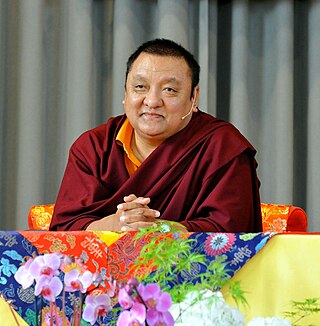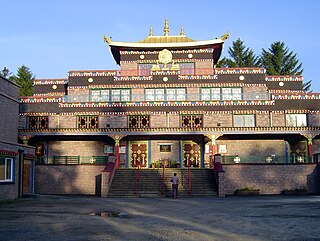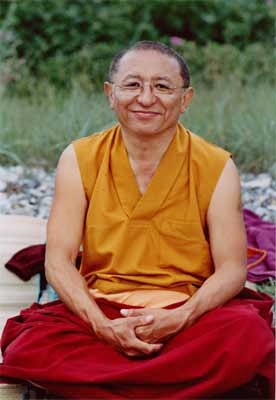
Chögyam Trungpa was a Tibetan Buddhist meditation master and holder of both the Kagyu and Nyingma lineages of Tibetan Buddhism.
A tulku is a distinctive and significant aspect of Tibetan Buddhism, embodying the concept of enlightened beings taking corporeal forms to continue the lineage of specific teachings. The term "tulku" has its origins in the Tibetan word "sprul sku", which originally referred to an emperor or ruler taking human form on Earth, signifying a divine incarnation. Over time, this term evolved within Tibetan Buddhism to denote the corporeal existence of highly accomplished Buddhist masters whose purpose is to ensure the preservation and transmission of a particular lineage.

The Shamarpa, also known as Shamar Rinpoche, or more formally Künzig Shamar Rinpoche, is the second oldest lineage of tulkus. He is one of the highest lineage holders of the Karma Kagyu school of Tibetan Buddhism and is regarded as the mind manifestation of Amitābha. He is traditionally associated with Yangpachen Monastery near Lhasa.

Kagyu Samye Ling Monastery and Tibetan Centre is a Tibetan Buddhist complex associated with the Karma Kagyu school located at Eskdalemuir, Scotland.
Tai Situpa is one of the oldest lineages of tulkus in the Kagyu school of Tibetan Buddhism In Tibetan Buddhism tradition, Kenting Tai Situpa is considered as emanation of Bodhisattva Maitreya and Guru Padmasambhava and who has been incarnated numerous times as Indian and Tibetan yogis since the time of the historical Buddha.

Chöje Akong Tulku Rinpoche was a tulku in the Kagyu school of Tibetan Buddhism and co-founder of the Samye Ling Monastery in Scotland, Tara Rokpa Therapy & ROKPA International Charity.

Thrangu Rinpoche was born in Kham, Tibet. He was deemed to be a prominent tulku in the Kagyu school of Tibetan Buddhism, the ninth reincarnation in his particular line. His full name and title was the Very Venerable Ninth Khenchen Thrangu Tulku, Karma Lodrö Lungrik Maway Senge. The academic title Khenchen denotes great scholarly accomplishment, and the term Rinpoche is a Tibetan devotional title which may be accorded to respected teachers and exemplars.

The sixteenth Gyalwa Karmapa, Rangjung Rigpe Dorje was the spiritual leader of the Karma Kagyu lineage of Tibetan Buddhism. Followers believed him to be part of the oldest line of reincarnate lamas in Vajrayana Buddhism, known as the Karmapas, whose coming was predicted by the Buddha in the Samadhiraja Sutra. The 16th Karmapa was considered to be a "living Buddha" and was deeply involved in the transmission of the Vajrayana Buddhism to Europe and North America following the Chinese invasion of Tibet. He had many monikers, including "King of the Yogis", and is the subject of numerous books and films.
Surmang refers to a vast alpine nomadic and farming region, historically a duchy under the King of Nangchen, with vast land holdings spreading over what is today the Tibet Autonomous Region and Qinghai Province. In Tibetan the King of Nangchen's realm was called the "nyishu dza nga" or the 21 (provinces). Since 1959 it is mainly within the Yushu Tibetan Autonomous Prefecture of Qinghai province in China. Yushu Prefecture is 97% ethnic Tibetan. The Surmang region is one of the poorest regions in China ranking it among the world's highest infant and maternal mortality, almost 100% illiteracy, and personal income of less than US 14¢/day. It is part of the catchment in China of the 30 million ultra-poor.

Sherab Palden Beru was an exiled Tibetan thangka artist who played a key role in preserving the art-form through the training of western students over a period of more than four decades.
Namgyal Rinpoche, Karma Tenzin Dorje (1931–2003), born Leslie George Dawson in Toronto, Canada, was a Tibetan Buddhist lama in the Karma Kagyu tradition.

Khenpo Karma Tharchin Rinpoche, widely known by his abbreviated name Khenpo Karthar Rinpoche, was a senior lama of the Karma Kagyu school of Tibetan Buddhism. Before his death he served as abbot of Karma Triyana Dharmachakra (KTD) Monastery in Woodstock, New York.

Pema Dönyö Nyinje is the 12th Tai Situpa, a tulku in Tibetan Buddhism, and one of the leading figures of the Karma Kagyu school. He is the head of Palpung Monastery.

Buddhism in Scotland is a relatively recent phenomenon. In Scotland Buddhists represent 0.24% of the population or around 13,000 people.
Yeshe is a Tibetan term meaning wisdom and is analogous to jnana in Sanskrit. The word appears for example in the title of the Lamrim Yeshe Nyingpo, a Vajrayana Buddhist sacred scripture that records oral teachings of Padmasambhava in the 9th century, and in the name of Yeshe Walmo, a deity of the Tibetan religion of Bon. It is used as a unisex given name by Tibetans and Bhutanese people, also spelled Yeshey, Yeshay, or Yeshi.

Chökyi Nyima Rinpoche is a Tibetan Buddhist teacher and meditation master. He is the abbot of Ka-Nying Shedrub Ling Monastery in Kathmandu, Nepal. He is the author of several books, founder of meditation centers around the world, and an international teacher.
Lama Chime Tulku Rinpoche is a Tibetan Buddhist, Tulku and Dharma teacher. Chime Rinpoche was born in 1941 in Kham, Tibet. In 1959, due to the annexation of Tibet, he was forced to flee to India via Bhutan into exile. Gaining British citizenship in 1965, he taught extensively throughout Europe and established Marpa House, the first Tibetan Buddhist Centre in England. His students include American author and Buddhist nun Pema Chödrön and musicians Mary Hopkin, David Bowie and Tony Visconti.

Kagyu Samye Dzong London Tibetan Buddhist Centre for World Peace and Health is the London branch of Kagyu Samye Ling Monastery in Scotland. Kagyu Samye Dzong London is under the direct guidance of Chöje Akong Tulku Rinpoche and Venerable Lama Yeshe Losal Rinpoche, the co-founder and Abbot of Samye Ling respectively.

Phakchok Rinpoche is a teacher of the Nyingma lineage and chief lineage holder of the Taklung Kagyu lineage of Tibetan Buddhism. He is Vajra Master of Ka-Nying Shedrup Ling monastery, abbot of several monasteries in Nepal, and assists monasteries and practice centers in Tibet. In addition, he serves as Director of the Chokgyur Lingpa Foundation, a nonprofit organization engaged in a wide range of humanitarian projects.
Tsikey Chokling Rinpoche was a teacher, writer, religious ritual master, and meditation master of the Nyingma school of Tibetan Buddhism.















